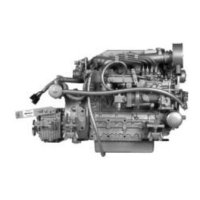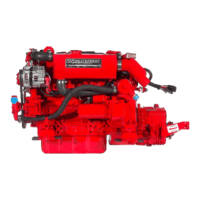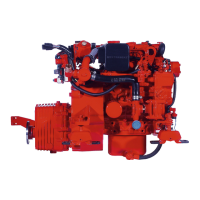HURTH
HBWJZF
TRANSMISSIONS
OPERATING
TEMPERATURE
A
WARNING:
If
the
transmission
fluid
temperature
is
too
high,
stop
the
engineimmedlatelyand
check
the
transmission
fluid.
NOlmal
operating
temperature of
the
transmission
flUId
should be
in
the range
of
122°F (50°C) to 212"F (100°C). A
maximum temperature
of
266°F (l30°C) may be only
reached
for
a
short
time.
Make
certain
there
is
enough space
around
the
transmission
to
provide good ventilation and cooling.
TRANSMISSION
COOLER
Some UNIVERSAL model's transmissions are equipped
with
an
exlernally
attached
convection
type
transmission
cooler.
The
cooler
is
a
separate
part
of
the
transmission
which
prevents
any
possibilities
of
coolant
diluting
the
transmission
fluid. However, the continued
flow
of
coolant thru the cooler
will,
in
time,
erode
the
inside
of
the
cooler causing
external
leaks.
A
transmission
cooler
may
last
ten
years
or
more
but,
in
some circumstances, depending
on
operating
hours,
tropical
waters, maintenance, etc. it might only last half that time.
WESTERBEKE recommends having a spare cooler aboard.
TIIANSMISSION
-~It.!::!.;~-"
ef!.!/9.~(!q1\fX
INSPECT
FOR
EROSION
AND
LEAKAGE
MAINTENANCE
Transmission
maintenance
is
minimal.
Keep
the
exterior
housing clean, check the fluid level
as
part of your regular
routine, and change the fluid every
300 operating hours.
Periodically inspect
the
transmission
and
the
cooler
for
leaks
and
corrosion.
Lubricate
the
cable connections.
Lay-up/Winterize
Storage requires special care. Follow these procedures:
D Drain water from the transmission oil cooler and replace
with
a
proper
mixture
of
antifreeze coolant.
NOTE:
This operation will normally occur when the
engine raw water cooling system is properly winterized.
D Clean up the transmission and touch up unpainted areas
(use heat resistant paiot).
D Fill the transmission with Dextran III
ATF
fluid
to
pre-
vent
"internal
corrosion
(extended
storage
only,
twelve
months
or
more),
. D
Loosen
attaching
hardware
from
the
transmission
output
flange and propeller shaft coupling flange before remov·
ing the boat from the water. Separate the flanges and
spray with lubricant.
D Inspect the gear shift cable, linkage, and attachments.
Look
for
corrosion
of
the
end
fittings,
cracks
or
cuts
in
the conduit, and bending
of
the actuator rods. Lubricate
all moving parts.
NOTE:
If the transmission is to be stored
for
a long time
(twelve months
or
more), it should be topped
off
with
fluid to prevent internal corrosion. Reduce the fluid level
before putting the engine back into
selVice.
For
additional
infonnation
contact:
HURTH MARINE GEAR
ZF Industries
Marine
US Headquarters
3131
SW
42nd Street
Fort Lauderdale,
FL
33312
Tel.: (954)
581·4040
Fax: (954) 581-4077
+
;.,Unlvanal
MARINE
POWER
39

